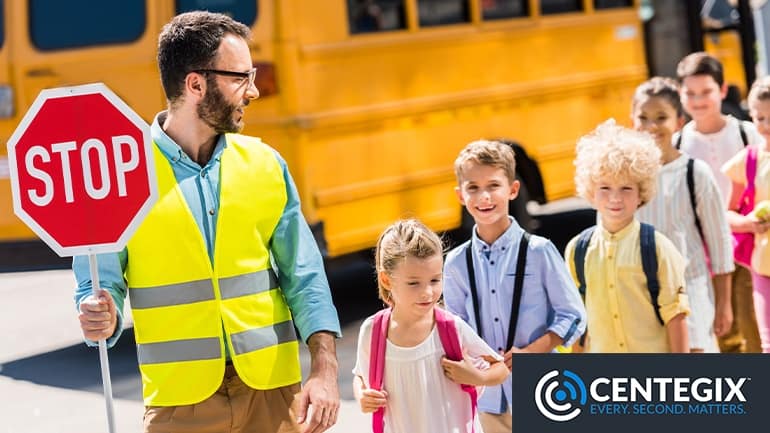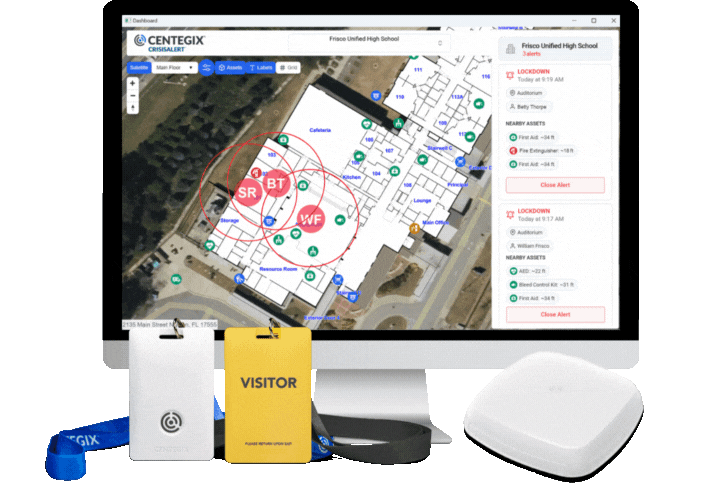Creating a safe and secure environment is of the utmost importance for schools. Safer environments ensure the well-being of students, teachers, and staff. They also play a crucial role in academic performance and teacher satisfaction.
Certainly, schools create their emergency response plans and Positive Behavioral Interventions and Supports (PBIS) programs with this goal in mind. That said, the addition of structural and technological support go a long way toward building a culture of safety in educational institutions. CENTEGIX® Safety Platform™ is the foundation for your school’s safety-focused culture.
The Connection between Safety and a Positive School Environment
A positive school environment goes beyond academic excellence. It encompasses the physical and emotional well-being of everyone within the school community. Schools create an atmosphere conducive to learning and personal growth when students and educators feel safe, respected, and supported. Many studies show the correlation between safety and positive school culture. These often emphasize how a secure environment leads to increased engagement and better educational outcomes.
Research on How Safety Influences Academic Performance and Teacher Satisfaction
Research proves that a school’s safety level impacts academic achievement and teacher satisfaction.
When students feel safe and secure in their school environment, they are more likely to take an active part in their learning and perform better. A positive school culture that prioritizes safety can lead to increased attendance, decreased truancy, and improved academic achievement.
In a study administered by the Research Alliance for New York City Schools, researchers found that of four dimensions of school climate—leadership and professional development, high academic expectations for students, teacher relationships and collaboration, and school safety and order—safety was most strongly correlated with academic improvement for students (Readiness and Emergency Management for Schools Technical Assistance Center [REMS TA], 2018).
A safe and supportive school culture not only benefits students but also teachers. Educators who feel safe and supported in their workplace are more likely to be satisfied with their job and less likely to experience burnout. This, in turn, can lead to higher teacher retention rates and a more stable learning environment for students.

In another study conducted on over 850,000 New York City fourth- and fifth-grade student observations over 8 years, researchers found that students in grade levels with higher teacher turnover score lower in both English language arts (ELA) and math. And these effects are more powerful in schools with more low-performing students (Ronfeldt et al., 2013).
CENTEGIX’s 2023 Spring Safety Trends Report highlights how safety incidents affect both teachers and students.
- the report indicates that everyday emergencies like medical and behavioral incidents make up 98% of all incidents related to safety. Campus-wide events such as lockdowns continue to represent a small percentage of incidents requiring a response.
- nearly half of all safety incidents on a school campus occur outside the classroom.
By understanding this data, school superintendents and district-level security decision-makers can better comprehend the importance of implementing effective safety solutions. More importantly, these decision-makers can apply the Safety Report data—and data from their own districts—to make informed decisions about their district safety and security policies and then tailor those to individual buildings across their domain.
Best Practices for Fostering a Culture of Safety in Educational Institutions
Creating a culture of safety requires a proactive approach that involves collaboration and planning. There are several best practices and strategies that school administrators can adopt to enhance safety measures. From staff training and emergency response protocols to cultivating a sense of community vigilance, these practices contribute to building a robust safety culture.
The following are recommendations from the Readiness and Emergency Management for Schools Technical Assistance Center.
- Employ a team of community members in the creation of emergency preparedness and response plans.
The team should include district and school leaders alongside classroom teachers and non-classroom-based educators, who can provide a unique perspective on how the day-to-day implementation of emergency response plans functions in reality. Parents and guardians should also be a part of this team.
- Conduct research to identify the current situation and issues at hand.
This research can and should include staff and student surveys around culture and climate as well as any real or perceived threats felt by the community at large. Address topics such as student bullying, student trust and relationships with their teachers, teacher perception of administrative support in a crisis, and adequacy of first aid response training for teachers and support staff.
- Use the research to create goals and objectives to address the issues discovered.
Publish data findings. Ensure that future plans are grounded in this data to maximize buy-in and support.
- Form a plan for accomplishing the goals outlined, being mindful of the data obtained.
Remember that the data and goals are your North Star; any planning unrelated to these goals is secondary and should be noted for another time or team to review.
- Review and present your plans for approval to other district leaders, stakeholders, and the community.
Be ready to address questions regarding funding, implementation, and more.
- Put your plans in place.
Train anyone and everyone involved in the implementation of your safety and security plans. Verify that updates to plans are addressed and outdated information is made explicit.
- Conduct necessary safety drills.
Collect feedback on their execution from classroom teachers and school administrators. Make adjustments as needed.
CENTEGIX CrisisAlert: A Technology that Complements a Safety-Focused Culture
CENTEGIX CrisisAlert is an advanced school safety solution designed to put safety at the forefront. The CrisisAlert wearable badge, a powerful panic button empowering quick human action during emergencies, boasts a 100% adoption rate among school staff. Its seamless integration with other emergency services technologies and precise, room-level location capabilities ensure a swift and effective response during moments of need.
CENTEGIX has evolved beyond being just a point solution; it has become an enterprise solution, providing much more than CrisisAlert. CENTEGIX has now become a full-scale safety platform. Safety Blueprint™ provides schools with digital mapping of their campuses—including information about safety devices like AEDs—which is valuable information for all staff and first responders in a moment of need. Moreover, Safety Blueprint maps are dynamic, giving school administrators the power to make informed decisions about where these devices should be housed. The maps can be updated to meet each school’s unique needs and features as they change. CENTEGIX’s recent acquisition of Ident-A-Kid’s iVisitor Management™ (IVM), now called CENTEGIX Visitor Management, enhances the management of all school traffic including staff, student tardiness, and visitors.
Additionally, strategic partnerships with
- Singlewire’s InformaCast® platform, which empowers districts to leverage existing investments to better respond to, notify, and manage emergency incidents
- RapidSOS, which securely links life-saving data from connected devices, apps, and sensors to RapidSOS safety agents, 911, and first responders globally in order to reduce response times and increase situational awareness during an on-campus emergency
unite diverse emergency services technologies, enabling comprehensive emergency preparedness for any situation. Whether it’s on-site badge-level activations or remote campus-wide alerts, CENTEGIX protects from various threats, including criminal activity, severe weather, and more.
High Satisfaction Levels and Proven Results
The success of any safety solution lies in its adoption and effectiveness. CrisisAlert users have repeatedly shared overwhelmingly positive experiences with the wearable CrisisAlert badge. From ease of use and feelings of safety and support to rapid resolution of incidents, CENTEGIX CrisisAlert receives high praise from teachers and staff.
“I have been a teacher for 15 plus years and wish we had this all along. It makes it much simpler and quicker to receive
help, especially in a high school setting.”
—GA High School Teacher
“The response was so fast and thankfully, my student was safe. It makes me feel safer in my school.”
—FL Elementary School Teacher
“I feel safe for the first time in a long time, and more importantly, I feel that I can respond quickly to help keep students
safe.”
—GA High School Teacher
Conclusion
Building a culture of safety in schools is a shared responsibility that requires continuous effort and the right tools. By understanding the impact of safety on the school environment and academic performance, educational institutions can prioritize safety solutions like CENTEGIX CrisisAlert. With its simple yet powerful technology, CENTEGIX complements and enhances your already safety-focused culture, demonstrating that every second truly matters regarding the well-being of students, teachers, and staff.
Review state-specific safety standards and funding opportunities for your school’s safety technology enhancements here.
To learn more about how CENTEGIX CrisisAlert can transform your school’s safety measures, sign up for a demonstration today.
Works Cited
Readiness and Emergency Management for Schools Technical Assistance Center. (2018). Student Perceptions of Safety and Their Impact on Creating a Safe School Environment [Fact sheet]. Retrieved from https://rems.ed.gov/docs/Student_Perceptions_Safety_Fact_Sheet_508C.pdf.
Ronfeldt, M., Loeb, S., & Wyckoff, J. (2013). How Teacher Turnover Harms Student Achievement. American Educational Research Journal. https://doi.org/10.3102/0002831212463813.











